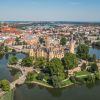City of Human Rights
Nuremberg is facing up to its history and would like to become a model of commitment and humanity.

Evelyn Konrád really enjoyed being in Nuremberg. She loved the Imperial Castle, the history, the culture: “We just don’t have that in the United States,” she says. But what impressed her in particular was that “Nuremberg raises its voice so loudly for the cause of human rights.” She explained that she had not been aware of that before and was certainly going to tell people in America about it. There is a very special reason for mentioning this story, which moved people in Nuremberg: Evelyn Konrád is 84 years old, and the old lady’s visit to Nuremberg in January 2013 was her first since she left the city at the age of three. Had to leave it, rather. From 1930 to 1932, her father, Jenö Konrád, had been the coach of the then-famous soccer club 1st FC Nuremberg. But he was also a Jew, which was why Der Stürmer, the anti-Semitic hate sheet, denigrated him, a former Hungarian national team player, in the worst possible way. Konrád read it – and left the country. With his wife Grete and his daughter Evelyn he emigrated to the United States, where he opened a curtain shop. The same publication, long since yellowed, is on show today in the soccer club’s small museum.
Adolf Hitler soon made Nuremberg the city of the Nazi party rallies. As a result, Nuremberg is linked more strongly with National Socialism than any other city. It is also a reason why Nuremberg tries more, and more visibly, than other cities to face up to that history. Nuremberg’s aim is to be a city that is associated with peace and human rights. This is stated in the first sentence of the guiding principles adopted by Bavaria’s second largest city in 2001: “On the basis of the special historical responsible of Nuremberg, we commit ourselves to actively implementing human rights.”
The whole city of Nuremberg is informed, even visually, by a sense of historical responsibility. The remnants of Hitler’s megalomania are still visible there; on the former Nazi party rally grounds, designed by Albert Speer, stands the Zeppelin Grandstand from which he enthralled the masses. For eleven years now, the Congress Hall, the remains of a building that was never completed but which indicates the kind of monstrous backdrop the whole ensemble was supposed to form, has housed the Documentation Centre Nazi Party Rally Grounds. Over one million people have already visited the centre. Yet there has always been an ongoing debate in Nuremberg about whether it was right to preserve the Nazi remnants, instead of simply letting them decay. Preserving the dilapidated Zeppelin Grandstand alone will now cost 75 million euros. “These are key sites of 20th century history,” says Hans-Christian Täubrich, head of the Documentation Centre, so for him there can be no doubt that the buildings have to be preserved. He frequently receives letters, especially from abroad, demanding this.
The Nazi party rallies and the Nuremberg Race Laws, with which Hitler legally enforced the persecution and discrimination of the Jews in 1935 and which Täubrich describes as the real collapse of German civilization, turned Nuremberg into a “place of perpetrators”, as the Lord Mayor of the City, Ulrich Maly, once called it. And Nuremberg is facing up to this. The Nuremberg Trials of 1945 and 1946 are also part of that history and made the city a milestone of international criminal law. Room 600 in Nuremberg’s Palace of Justice, where the Nazi grandees were tried, is still a courtroom. The walls still have their dark panelling; only the furniture has been changed. Part of the original prisoner’s dock is on the building’s top floor, where in November 2012 the Memorium Nuremberg Trials was opened, an exhibition informing visitors about the trials and their heritage, up to and including the International Court in The Hague. Currently, the International Academy Nuremberg Principles (IANP) is being instituted with the aim of further developing the so-called Nuremberg Principles, which resulted from those trails and formed the basis of international law.
When you enter the office of Martina Mittenhuber, historian and head of the Human Rights Office of the City of Nuremberg, you have finally arrived at the very heart of the city’s human rights work. On the wall is a UNESCO certificate awarded to Nuremberg in 2000 for its work in human rights education. “Nuremberg has succeeded in transforming a grave historical heritage into a positive task for the future,” says Mittenhuber, thereby explaining why Nuremberg is the only city in Germany to have its own Human Rights Office. It all began in 1995 with the Nuremberg International Human Rights Award which the city has since presented every two years. The award was to be a symbol of Nuremberg’s resolve to never again send signals of anything but peace, and also a form of protection for the prize-winners, whose dedication to human rights exposes them to danger. The Russian Sergei Kovalev won the first prize in 1995 for his campaign against the war in Chechnya; in 2013 Kasha Jacqueline Nabagesera from Uganda will receive the award for her struggle against homophobia.
“It soon became evident that human rights work had to have an impact not only outwardly, but also inwardly,” says Martina Mittenhuber. This gave rise to the Human Rights Office. Its outward impact means, for example, that all the city’s employees have to do training in human rights education. “Our aim is to generate a certain approach towards encountering others with respect.” That is why Nuremberg is also the only city in which the local government has set up an anti-discrimination office, also at the initiative of the Human Rights Office. Martina Mittenhuber and her five colleagues deal with refugee issues, campaign against right-wing extremism, draw up guidelines for housing associations or define ethical principles for care-giving. “We have brought human rights work into civil society,” she says. “That is quite avant-garde in Germany.”
This human rights work not only has repercussions in the city administration, it is also visible, for example, in the almost 70 gingko trees throughout Nuremberg, which represent the individual articles of the Universal Declaration of Human Rights. Visitors on their way to the main entrance of the Germanisches Nationalmuseum walk along the Way of Human Rights, which is a work of art by Israeli artist Dani Karavan. The pathway is lined by white concrete pillars, on each of which an article is engraved in German and another language. The first reads “All human beings are born free and equal in dignity and rights” – in Yiddish.
Evelyn Konrád also read this and was very moved. She did not have a bad word to say about the city, which she herself scarcely remembers. But her parents were very happy here, she says, until they were forced to leave. Whereby forced to leave is not really the right term, she thinks. “Those were the voices of the Nazis, not of the city.” ▪

